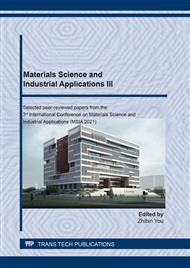[1]
Zhou W, Hu M, Zang X, Liu Q, Du J, Hu J, Zhang L, Du Z, Xiang Z (2020) Luteolin attenuates imiquimod–induced psoriasis-like skin lesions in BALB/c mice via suppression of inflammation response. Biomedicine & Pharmacotherapy 131:110696.
DOI: 10.1016/j.biopha.2020.110696
Google Scholar
[2]
Fang J, Cai C, Chai Y, Zhou J, Huang Y, Gao L, Wang Q, Cheng F (2019) Quantitative and systems pharmacology 4. Network-based analysis of drug pleiotropy on coronary artery disease. European Journal of Medicinal Chemistry 161:192-204.
DOI: 10.1016/j.ejmech.2018.10.020
Google Scholar
[3]
Liu F, Zhang Y, Yu Q, Shen Y, Zheng Z, Cheng J, Zhang W, Ye Y (2019) Exploration of the binding between ellagic acid, a potentially risky food additive, and bovine serum albumin. Food and Chemical Toxicology 134:110867.
DOI: 10.1016/j.fct.2019.110867
Google Scholar
[4]
Daily JW, Kang S, Park S (2020) Protection against Alzheimer's disease by luteolin: Role of brain glucose regulation, anti‐inflammatory activity, and the gut microbiota‐liver‐brain axis. BioFactors.
DOI: 10.1002/biof.1703
Google Scholar
[5]
Sarmah S, Das S, Roy AS (2020) Protective actions of bioactive flavonoids chrysin and luteolin on the glyoxal induced formation of advanced glycation end products and aggregation of human serum albumin: In vitro and molecular docking analysis. International Journal of Biological Macromolecules 165: 2275-2285.
DOI: 10.1016/j.ijbiomac.2020.10.023
Google Scholar
[6]
Abdel-Mageed W, M. Al-Saleem M, Al-Wahaibi L, Rehman M, AlAjmi M, Alkahtani R (2020) Phenolic compounds of Heliotropium europaeum and their biological activities. Pharmacognosy Magazine 16 (68):108.
DOI: 10.4103/pm.pm_376_19
Google Scholar
[7]
Tang J, Huang R, Zheng S, Jiang S, Yu H, Li Z, Wang J (2019) A sensitive and selective electrochemical sensor based on graphene quantum dots/gold nanoparticles nanocomposite modified electrode for the determination of luteolin in peanut hulls. Microchemical Journal 145:899-907.
DOI: 10.1016/j.microc.2018.12.006
Google Scholar
[8]
Li X, Zou R, Niu Y, Sun W, Shao T, Chen X (2018) Gold Nanocage-Based Electrochemical Sensing Platform for Sensitive Detection of Luteolin. Sensors 18 (7):2309.
DOI: 10.3390/s18072309
Google Scholar
[9]
Gao F, Tu X, Ma X, Xie Y, Zou J, Huang X, Qu F, Yu Y, Lu L (2020) NiO@Ni-MOF nanoarrays modified Ti mesh as ultrasensitive electrochemical sensing platform for luteolin detection. Talanta 215:120891.
DOI: 10.1016/j.talanta.2020.120891
Google Scholar
[10]
Wang L, Lu S, Deng Y, Wu W, Wang L, Liu Y, Zu Y, Zhao X (2020) Pickering emulsions stabilized by luteolin micro‐nano particles to improve the oxidative stability of pine nut oil. Journal of the Science of Food and Agriculture.
DOI: 10.1002/jsfa.10739
Google Scholar
[11]
Nguyen TKL,Oh MM (2020) Physiological and biochemical responses of green and red perilla to LED‐based light. Journal of the Science of Food and Agriculture 101 (1):240-252.
DOI: 10.1002/jsfa.10636
Google Scholar
[12]
Sowndarya J, Farisa Banu S, Madhura G, Yuvalakshmi P, Rubini D, Bandeira Junior G, Baldisserotto B, Vadivel V, Nithyanand P (2019) Agro food by-products and essential oil constituents curtail virulence and biofilm of Vibrio harveyi. Microbial Pathogenesis 135:103633.
DOI: 10.1016/j.micpath.2019.103633
Google Scholar
[13]
Mülazımoğlu İE, Mülazımoğlu AD (2012) Investigation of Sensitivity Against Different Flavonoid Derivatives of Aminophenyl-Modified Glassy Carbon Sensor Electrode and Antioxidant Activities. Food Analytical Methods 5 (6):1419-1426.
DOI: 10.1007/s12161-012-9393-7
Google Scholar
[14]
Prakash A, Nithyanand P, Vadivel V (2018) In vitro antibacterial activity of nut by-products against foodborne pathogens and their application in fresh-cut fruit model. Journal of Food Science and Technology 55 (10):4304-4310.
DOI: 10.1007/s13197-018-3373-x
Google Scholar
[15]
Taskin T, Dogan M, Arabaci T (2020) Bioassay-guided isolation and antiproliferative efficacy of extract loaded in chitosan nanoparticles and LC-QTOF-MS/MS analysis of Achillea magnifica. South African Journal of Botany 133:236-244.
DOI: 10.1016/j.sajb.2020.08.002
Google Scholar
[16]
Cao M, Yin X, Bo X, Guo L (2018) High-performance electrocatalyst based on metal-organic framework/macroporous carbon composite for efficient detection of luteolin. Journal of Electroanalytical Chemistry 824:153-160.
DOI: 10.1016/j.jelechem.2018.07.049
Google Scholar


